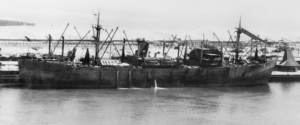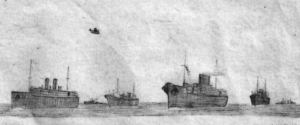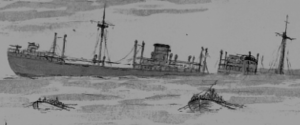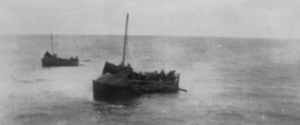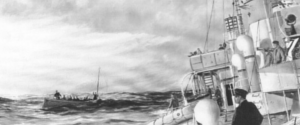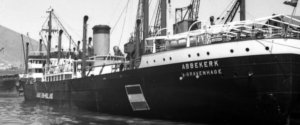Abadan, Persia (Iran) contribution to the Persian Corridor

28 May 1942. In Abadan finally the locomotives are unloaded. Third mate Visser looks at it with mixed feelings.
The Iranian Railroad. Impression of the Route, Statistics and Gallery .
(Source: http://www.o5m6.de/Rail.html)First we unloaded the wooden beams and sleepers, and again inevitable some hit the locomotives while hauled out. Then we docked next to a big crane in Abadan. The crane was able to lift the locomotives, but struggled to get them over the side of the ship. But then in the end all locomotives were out. They were wrecks by now. One smokestack was bent, another cabin was smashed, they were all damaged. But then we couldn’t do anything about it anymore and that’s how we left them.
Third mate Jacob Visser
The Persian Corridor is 1 out of 3 ways through which large quantities of goods and equipment have to be transported to the USSR as part of the Lend-Lease program. After the infamous arctische convoys to Murmansk this is, potentially, the safest and most efficient route. At this time though it certainly isn’t yet. 6 Months ago Persia had been ‘peacefully’ occupied by the Brits and Russians and they have trouble processing the enormous amount of goods arriving in the ports and transport them by one, single track rail road and some land routes through mountains and deserts to the Russian border 2500 km away. Improving the infrastructure goes slowly and the locomotives the Abbekerk brought are just some of the 143 shipped there in the last six months.

Not all locomotives arrive. This one ended on the bottom of the Red Sea when SS Thistlegorm was sunk by German planes.
The locomotives are now hoisted up on pontoons and towed over the river Karun to the town of Ahvaz 150 km inland. There they are meant to be put on the rail road track although it seems they will need thorough repairs before that can happen.
By the end of 1942 the US will take over the organization and they also bring diesel locomotives. On such a track through wasteland with mountains, deserts and little water they are more practical than the coal- and oil fired steam locomotives which are on top of everything else extremely uncomfortable for their crew, especially in the 144 tunnels.
Abbekerk receives new orders. Not to Australia to get more wheat but to Trinidad in the Caribbean to pick up a load of sugar for Great Britain. That means a voyage of more than a month via Durban to Port of Spain, Trinidad. Well over 16.000 miles (30.000 km) that’s a distance of almost ¾ of the circumference of the world.
And so we left Abadan in ballast. That is, we have loaded a large lot of stones as ballast and left empty to Durban and the Cape to Trinidad.
Third mate Jacob Visser
That ballast is needed for the stability and draft necessary to keep the ships propeller and rudder below water. Also all the fuel tanks are filled. That’s no problem being moored next to the largest oil refinery in the region.

